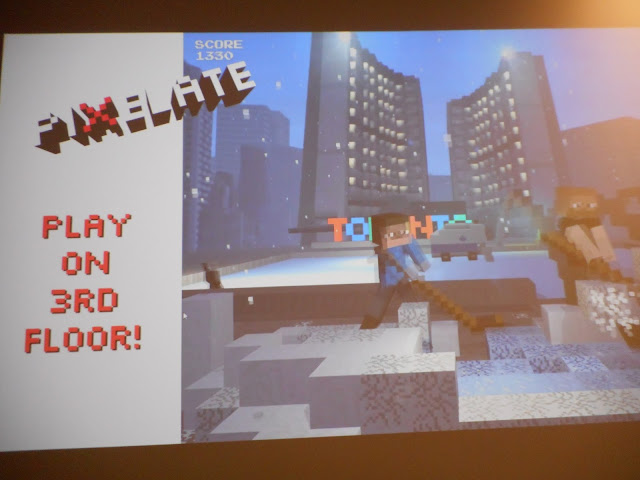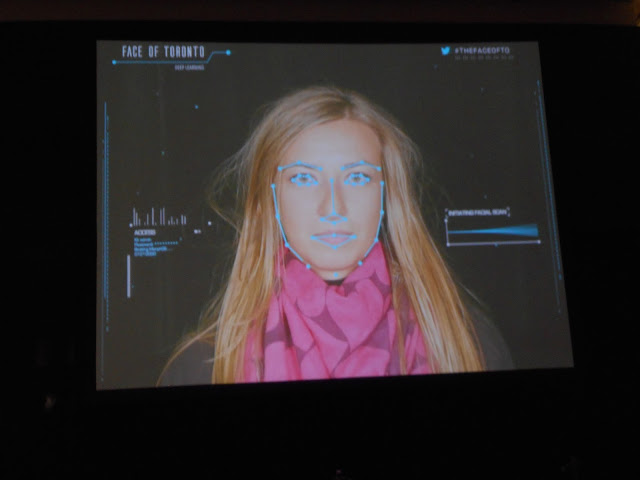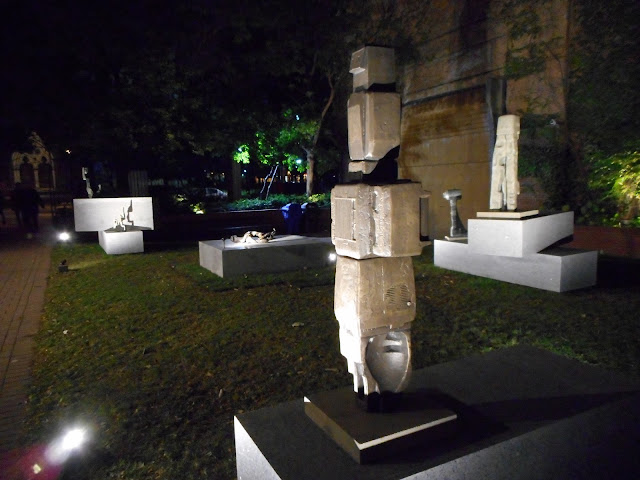I suppose it is possible to see all the pieces in one 12-hour period (and if you have, well-done), but I've usually chosen a narrower path that I could walk in a few hours, based partially on pieces highlighted/recommended in local media. Who knows what I've missed as a result, but a person can only do so much! As it is, I am usually quite exhausted by the time I call it quits (not a kid anymore).
This year, I checked out the Nuit Blanche website, and decided to follow a roughly L-shaped path (okay, maybe more of a zigzag), starting from Dundas & McCaul, and ending around Queen's Quay & Parliament. I have lots of pictures, though not of everything.
The Journey
My first stop was at St. George the Martyr church, off McCaul, and a piece by Mary Ma called Reverence In Reverie, an image of blue skies projected onto a circular screen suspended in the middle of the room.
Then it was on to the TIFF Bell Lightbox, where I ended up spending most of three hours sitting (very welcome) and enjoying several pieces, the first of which was called LIKE/COMMENT/SUBSCRIBE, a collection of strange, quirky or humourous videos posted to the internet over the years:
This was literally an all-night program, every hour on the hour, with different postings being played each time. So you could have stayed there all night if you wanted!
Other pieces there included KINO-BLENDER, a darkly humourous mashup of trailers, scenes and dialogue from movies over the years, that went about an hour.
Another piece was called Gauge, a time-lapse film taken in Canada's lower Arctic, with a group of artists painting indigenous-themed scenes on walls of ice and snow that seemed to rise from the tundra, then sink again.
There was also a fun piece called Pixelate, where participants could perform some activity against a background. These would be filmed, then pixelated, to resemble an old-school video game.
Here's a photo of it that better illustrates what I mean:
As I said, this visit took some time.
Next, it was over to David Pecaut Square for this installation by Stefan Verstappen, called Tri-monic: Shape, Sound, Sight. Passersby were invited into this circle of three lit-up plinths to play a keyboard or stringed instrument, or sing or speak into a microphone. The sounds were amplified and distorted into a kind of sound collage.
Along the way to the next piece, I was struck by this installation, by Friends With You, entitled Light Cave. As you can see, it's a polymorphous piece of stitched-together, inflated canvas, lit from within. People were invited to walk through, talk to others, take photos or selfies, or whatever they wished.
The next piece was very cool. It was by the software company Architech, and called The Face of Toronto. People lined up and got their picture taken, which was then mapped (as you see in the pictures), to be made into a series of faces that would morph from one to another, to reflect the diversity of Toronto's citizens. The finished project is supposed to be available on the company's website.
In case you're wondering, there was a long lineup, so no, I didn't get my pic taken. Here's the link, though (copy & paste): http://www.architech.ca/#/labs/nuit-blanche2015
Then, it was on to the Tundra Restaurant at the Hilton Hotel at University & Richmond, for a fascinating piece by Maziar Ghaderi called Mirada: Holographic Fire X Interactive Technology. When I arrived, there was a native poet, Duke Redbird, reciting a poem as people sat on banquettes around the perimeter of the room, and electronically-enhanced sounds of nature played. You can see Mr. Redbird, with microphone, just to the right of centre in this picture:
What was striking about this piece was that there was no actual fire; What appeared to be flame in the central glass piece was actually reflections of projections in each of the four monitors around it, giving a "holographic" effect:
Then, up to Nathan Phillips Square for a very ambitious project by JR called Inside Out. Once again, people were invited to have their picture taken, and the photos were enlarged and displayed on various surfaces around the square, as in this picture, where they're on the now-iconic TORONTO sign:
Enlarged pictures were also being pasted to the concrete of the square itself...
...as well as to the wall of the ramp up to the rotunda level:
And, here is the view from the rotunda level of the whole thing. It's hard to tell in the dark, but it almost seems to be in the form of a maze.
At top right, you can see the photo booth (oddly enough, called "photo booth") where people got their picture taken. As you may have noticed by the pictures, it seems like they were encouraged to use whatever facial expression struck their fancy!
The other very striking installation at the square was called Park Here, by Katy Chey. It plays on both meanings of that title (i.e., park your car here/here is a park), and the artist created a parklike environment right in the city hall parking lot.
I loved the contrast between the drab, mundane poured concrete of the parking garage and the green trees, bushes, and wood-chip flooring of this installation.
The next stop for me was the gazebo at St. James Park at King & Church, to see a project by a group called the Department of Imaginary Affairs, entitled The East Side Story. It was a giant, six-page book, laid out on the floor of the gazebo, with writings and photos by residents of Toronto's east end.
It looked like "East End" was fairly broadly defined, as there were testimonies from people in the Cabbagetown, Leslieville, and Beach areas, among others.
You could also write a personal message on a large piece of canvas, which, as a long-time resident of the east side, I did.
Across the street, at the Sculpture Garden, was a piece by An Te Liu called Solid States. The artist took found pieces, cast them in bronze, and made abstract sculpture with them. It seemed like many of the pieces originated from styrofoam packing material.
A couple of the pieces were decidedly anthropomorphic in nature, as this closer look at the one in the foreground of the above pic will demonstrate:
Then, it was down (and back) to Union Station, where there were a couple of installations, including this colourful fabric piece by Amanda McAvour, called Pattern Study:
On the way south from there, there was this interesting/eerie/unsettling piece by, once again, JR, projected on the Union Station overpass, called The Eyes of the Bridge. The eyes were in constant motion, as if watching passersby.
Down at Waterpark Place was this sound installation by Marguerite Humeau. It was part of the "Beaufort" series for this night, and is called called Screams From Hell, actual sounds that emanate from the earth's crust (no, no, not the people talking, the eerie tones in the background):
Further along Queen's Quay, at the Westin Harbour Castle hotel, was this amazing piece, also part of the "Beaufort" series. It's by Los Carpinteros, and is called Frio Estudio del Desastre. It simulates the moment of impact of a shell on a concrete-block wall:
I couldn't resist taking a shot through the hole in the wall (actual cinderblocks, by the way) from the other side:
What a breathtaking piece of work!
Continuing along Queen's Quay, another in the "Beaufort" series, this one called Hit, by Christof Migone, in which performers (in this picture, two people in a trailer) made sounds by striking a microphone against various surfaces, or by vocalizing...
...which were then transformed/processed/mutilated into this incredible collage of noises by a DJ/mixer:
Next was another "Beaufort" piece, by Heather & Ivan Morrison, called The Cleaving, large piles of logs which people could walk through:
Then, there was another highlight of the night, another "Beaufort" piece, by Robert Wysocki, called Lava Field, actual lava produced by melting rock in a coke-fired furnace and allowing it to flow over the ground outside the Lakeshore campus of George Brown College.
You could feel the heat off this thing, though it was cold and windy on the lakeshore. Sparks were flying everywhere, and I even got a small one in my eye! No damage, though.
Yep, real lava.
There was another piece along Queen's Quay, another of the "Beaufort" series, called Dispersal Zone. The artist, Tim Knowles, used generators to pump a substance through the streetlights that emitted a cloud from each one. As you can see, the effect was quite striking, with the wind blowing the clouds in every direction:
Finally, there was this fascinating work by Tomas Saraceno, the first of the "Beaufort" series, called Cumulus. It was a projection against the Victory Soya Mills silos, and was a very slow-moving series of changing cloud patterns. A few sequential shots might be the best way to show how this worked:
Well, that was all the exhibits I took in for this year. As a capper, I turned around from that location (Queen's Quay & Parliament) and took the final pic of the night, of Toronto's ever-changing skyline. Then it was on to the streetcar and home, just after 2 a.m.
In Summary
This was a rewarding night, as Nuit Blanche usually is.
Whether we acknowledge it or not, we rely on artists, of any type, to help us see things differently, to take us away from the mundane for a while. If our eyes are opened, our perceptions challenged (and hopefully changed), and if we have a little fun along the way, then the efforts of these people will have been worth it. They are to be congratulated.

































No comments:
Post a Comment